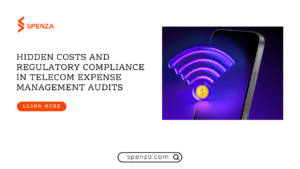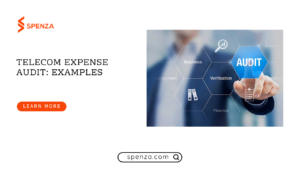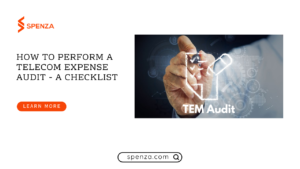Table Of Contents
- Introduction
- What is Telecom Expense Management (TEM)?
- What is Telecom Expense Management Audit?
- Why TEM Audits Matter in Today’s Business Environment?
- What are the Hidden Costs Behind Telecom Services?
- Common Billing Errors and Overcharges
- Unused Services and Zombie Assets
- Contract Discrepancies and Their Financial Impact
- How to Uncover Potential Savings Through Telecom Audits?
- Immediate vs. Long-term Savings Opportunities
- Quantifying ROI from TEM Audits
- What are the regulatory compliance requirements for Telecom expense audits?
- Industry-specific Compliance Requirements
- Data Security and Privacy Regulations
- Risk Management Through Compliance Adherence
- How to Optimize Telecom Expense Management Strategies?
- Creating an Effective TEM Framework
- Automation and Technology Solutions
- Integration with Overall Business Strategy
- What Are the Best Practices for Reducing Telecom Audit Costs?
- Inventory Management and Rationalization
- Contract Negotiation Techniques
- Implementing Effective Governance Controls
- What are the Benefits of a Telecom Expense Audit?
- How Do You Select the Right TEM Audit Partner?
- Key Qualifications and Expertise to Look For
- Questions to Ask Potential TEM Providers
- Building a Collaborative Relationship
- Spenza’s TEM Solution
- Overview of Spenza’s TEM Services
- Unique Features and Benefits
- Conclusion
- FAQS

Introduction
In today’s digital-first business environment, telecommunications has become the backbone of organizational operations. From mobile devices to cloud services, and internet connectivity to specialized communication tools, businesses rely heavily on telecom services to maintain productivity and competitiveness. However, this dependency comes with significant expenses that often go unmonitored and unoptimized. As telecom environments grow increasingly complex, organizations face challenges in managing these expenses effectively, leading to unnecessary costs and compliance risks.
What is Telecom Expense Management (TEM)?
Telecom Expense Management (TEM) is a strategic approach that helps organizations manage and optimize their telecommunications costs. It encompasses a range of tasks, processes, technologies, and services designed to streamline the management of telecom expenses, including fixed and mobile telephony, data services, and related IT services.
Telecom Expense Management (TEM) has grown beyond invoice processing to include managing mobile devices, cloud services, and IoT connectivity. As businesses rely on more advanced communication tools, TEM helps them reduce costs, improve visibility, and maintain better control over their telecom expenses, making it essential for efficiency and savings.
What is Telecom Expense Management Audit?
A Telecom Expense Management (TEM) audit is a thorough review of a company’s telecom expenses to identify billing errors, unused services, and cost-saving opportunities. It examines invoices, contracts, and usage patterns to eliminate overcharges and optimize telecom assets.
What a TEM Audit Involves:
- Invoice & Billing Review – Detects errors, overcharges, and discrepancies.
- Contract Analysis – Ensures terms align with actual usage and industry benchmarks.
- Inventory Management: Ensuring that the company has a clear understanding of its telecom assets and services.
- Regulatory Compliance Check – Verifies adherence to policies and industry standards.
- Usage Optimization – Analyzing telecom usage patterns to identify areas where services can be optimized or reduced.
A TEM audit analyzes data, generates reports, and implements cost-saving strategies, helping businesses reduce expenses, improve efficiency, and enhance telecom management.
Why TEM Audits Matter in Today’s Business Environment
In today’s fast-changing telecommunications landscape, TEM (Telecom Expense Management) audits are crucial for several reasons:
- Cost Control: Telecommunications can take up 3-4% of a company’s revenue. Even small inefficiencies can lead to significant unnecessary costs.
- Technology Transitions: As companies move from old systems to cloud-based communications, audits ensure the best setup and pricing during these changes.
- Remote Work Expansion: The rise of remote and hybrid work has made managing telecom expenses more complex, requiring better tracking and optimization of costs.
- Vendor Consolidation: The telecom industry sees frequent mergers and acquisitions, leading to contract and service changes that need careful review.
- Regulatory Evolution: Changing compliance requirements mean telecom practices must be regularly assessed to stay within current regulations.
Without regular telecom audits, organizations risk financial losses, compliance issues, security risks, and inefficient service arrangements.
What are the Hidden Costs Behind Telecom Services?
Telecom services often come with hidden costs that can be hard to spot. Here are some common issues:

1. Billing Errors and Overcharges:
- Wrong Rates: Sometimes, service providers don’t apply agreed discounts or special rates.
- Unauthorized Charges: Services added without permission.
- Duplicate Billing: The same service is billed multiple times.
- Billing After Cancellation: Charges continue after a service is stopped.
- Tax and Fee Errors: Incorrect taxes or fees added to bills.
These errors are common because telecom bills are complex and hard to review. Studies show that 7-12% of telecom charges have errors.
2.Unused Services and Zombie Assets:
Zombie assets are services or equipment still being charged despite not being used. Examples include:
- Landlines for ex-employees
- Old mobile devices are not deactivated.
- Data circuits for closed locations
- Unused software licenses
- Maintenance of retired equipment
These costs persist due to poor inventory management or lack of visibility. TEM audits help identify and eliminate these costs.
3. Contract Issues:
- Minimum Spending Penalties: Paying penalties for not meeting spending commitments.
- Auto-Renewals: Contracts renewing at worse terms without notice.
- SLA Violations: Providers not meeting service levels without giving credits.
- Contract Misinterpretation: Disputes from unclear contract terms.
These issues can be costly, especially for large organizations with many service agreements.
How to Uncover Potential Savings Through Telecom Audits?
Immediate vs. Long-term Savings Opportunities
TEM audits typically reveal two categories of savings opportunities:
| Category | Savings Opportunity | Description |
|---|---|---|
| Immediate Savings | Billing Error Recovery | Identifies and recovers overcharges and billing mistakes, often with retroactive credits. |
| Elimination of Unused Services | Removes inactive services and ‘zombie’ assets that still incur charges. | |
| Tax and Fee Corrections | Ensures accurate application of tax and regulatory fees to avoid unnecessary expenses. | |
| Contract Compliance Resolution | Identifies and addresses non-compliance issues in existing telecom contracts. | |
| Long-term Savings | Contract Renegotiation & Optimization | Improves contract terms for better pricing and cost efficiency. |
| Service Rationalization & Standardization | Streamlines services to reduce redundancy and enhance efficiency. | |
| Governance & Approval Processes | Implements controls to prevent overspending and unauthorized service activations. | |
| Technology & Service Model Upgrades | Adopts more cost-effective and modern telecom solutions. |
Effective TEM initiatives address both categories, balancing quick wins with strategic improvements to the organization’s telecom management practices.
Quantifying ROI from TEM Audits
TEM audits can provide significant returns on investment. Here’s how:
- Historical Recovery: Organizations usually recover 8-12% of audited spending by finding billing errors and contract issues.
- Ongoing Cost Reduction: Telecom expenses can be reduced by 15-25% through optimizing services and eliminating waste.
- Productivity Improvements: Reduces the administrative workload of managing telecom services and processing invoices.
- Risk Mitigation: Lowers the risk of compliance violations and associated penalties.
The best ROI comes from continuous TEM practices rather than one-time audits, as ongoing monitoring prevents new inefficiencies from developing.
What are the regulatory compliance requirements for Telecom expense audits?
Industry-Specific Requirements
- Healthcare: Must follow HIPAA rules to protect patient information.
- Financial Services: Must record calls, verify transactions, and archive communications.
- Public Sector: Must follow procurement rules and be transparent about telecom spending.
- International Operations: Must comply with each country’s telecom regulations.
Data Security and Privacy
- GDPR and Privacy Laws: Protect personal data in communications.
- PCI DSS: Secure payment card information.
- Data Sovereignty: Rules about where data can be stored and processed.
- Breach Notification: Report security incidents.
Risk Management
- Regulatory Risk: Avoid penalties for non-compliance.
- Reputational Risk: Protect brand and customer trust.
- Operational Risk: Prevent service disruptions.
- Financial Risk: Avoid unexpected costs.
TEM audits help identify compliance gaps, prevent violations, and manage risks by ensuring telecom services meet these requirements.
How to Optimize Telecom Expense Management Strategies?
1. Creating an Effective TEM Framework
- Clear Governance: Define roles and responsibilities.
- Documented Policies: Standardize processes for service requests and approvals.
- Inventory Management: Track telecom assets and services.
- Contract Management: Centralize and manage service agreements.
- Dispute Resolution: Address billing discrepancies.
- Performance Metrics: Use KPIs to measure effectiveness.
2. Automation and Technology Solutions
- Invoice Processing: Automate charge validation.
- Inventory Tracking: Monitor active services and usage.
- Order Management: Streamline provisioning and decommissioning.
- Reporting and Analytics: Generate automated reports.
- Allocation and Chargeback: Distribute costs to cost centers.
3. Integration with Overall Business Strategy
- Budget Planning: Use TEM insights for telecom budgeting.
- Digital Transformation: Support new communication technologies.
- Business Continuity: Ensure service redundancy and resilience.
- Merger and Acquisition Support: Facilitate telecom integration.
- Sustainability Goals: Optimize resource use and reduce environmental impact.
Aligning TEM with broader organizational goals ensures it contributes to overall success beyond just cost reduction.
What Are the Best Practices for Reducing Telecom Audit Costs?
1. Inventory Management and Rationalization
- Centralized Inventory: Keep an up-to-date list of all telecom services and assets.
- Regular Reconciliation: Match inventory with invoices and physical assets.
- Decommissioning Procedures: Remove services no longer needed.
- Standardize Configurations: Reduce complexity by standardizing services.
- Review Allocations: Ensure services meet actual business needs.
2. Contract Negotiation Techniques
- Competitive Bidding: Use competition to get the best prices.
- Flexible Commitments: Align contracts with expected business changes.
- Service Level Agreements: Include penalties for poor service.
- Technology Refresh Rights: Keep capabilities up-to-date.
- Benchmarking Provisions: Ensure ongoing competitiveness.
3. Effective Governance Controls
- Approval Workflows: Require approval for new service requests.
- Clear Accountability: Assign responsibility for telecom management.
- Regular Audits: Periodically review telecom services and expenses.
- Automated Alerts: Monitor for unusual spending or usage.
- Usage Policies: Set standards for acceptable use.
These practices help achieve sustainable cost reduction and prevent inefficiencies.
What are the Benefits of a Telecom Expense Audit?
Financial Benefits
- Cost Reduction: Save 15-35% on telecom expenses.
- Recover Overcharges: Identify and recover past billing errors.
- Improved Budgeting: Better forecast and allocate telecom budgets.
- Lower Admin Costs: Increase process efficiency to reduce administrative expenses.
Operational Benefits
- Enhanced Visibility: Gain clear insights into telecom assets and services.
- Improved Performance: Ensure services are appropriately provisioned.
- Time Savings: Reduce time spent managing telecom issues.
- Alignment with Needs: Match services to actual business requirements.
- Regulatory Compliance: Ensure adherence to relevant regulations.
These benefits are amplified when audits are part of ongoing TEM practices.
How Do You Select the Right TEM Audit Partner?
- Industry Experience: They should understand the telecom challenges specific to your sector.
- Technical Expertise: Knowledge of current and emerging communication technologies.
- Analytical Capabilities: Use advanced tools to identify optimization opportunities.
- Carrier Relationships: Have established connections with service providers to resolve issues quickly.
- Implementation Support: Can help you put their recommendations into action.
- Ongoing Management: Offer continuous support beyond the initial audit.
A good partner balances technical skills, industry knowledge, and practical experience. For example, Butlr.io faced high telecom expenses across multiple countries and inefficient data plans. By choosing Spenza, Butlr.io reduced costs and improved operational visibility worldwide. This demonstrates how the right TEM partnership can greatly enhance connectivity management for tech companies.
Questions to Ask Potential TEM Providers
- How do you identify billing errors and optimization opportunities?
- How do you keep up with evolving telecom technologies and regulations?
- Can you provide references from similar organizations?
- What is the typical return on investment (ROI) timeframe for your TEM services?
- How do you handle sensitive data during the audit process?
- What kind of support do you offer after the initial audit?
Their answers should show both technical skill and alignment with your organization.
Spenza’s Telecom Expense Management (TEM) Solution
Spenza’s TEM helps businesses manage their telecom expenses effectively. They use advanced technology and expert knowledge to:
- Audit and Analyze Bills: Check telecom bills for errors and savings.
- Process and Validate Invoices: Ensure invoices are correct and paid on time.
- Optimize Contracts: Help negotiate better telecom contracts.
- Manage Inventory: Keep track of telecom assets and services.
- Assess Compliance: Ensure telecom practices follow regulations.
- Continuous Management: Ongoing support to keep telecom expenses in check.
When organizations partner with Spenza, they typically experience significant cost savings, improved telecom management processes, and enhanced visibility into their telecom operations.
Conclusion
Telecom Expense Management (TEM) audits help organizations uncover hidden costs and ensure regulatory compliance. By addressing billing errors, eliminating unused services, and improving governance, companies can reduce telecom expenses by 15-35%. Combining initial audits with ongoing TEM practices leads to lasting savings and operational improvements. As telecommunications grow more complex, proactive TEM is essential for efficiency and compliance, offering immediate financial benefits and long-term competitive advantages.
FAQs
A telecom audit is a thorough review of a company’s telecommunications services and related expenses.
Telecom expense management solutions help businesses track and control spending, optimize service usage, and negotiate better contracts.
Organizations should conduct comprehensive telecom audits annually, with continuous monitoring between audits to prevent inefficiencies.
Spenza offers comprehensive contract analysis, real-time data tracking, and continuous compliance monitoring.
Organizations can expect immediate recovery of billing errors, reduced telecom expenses by 15-35%, and improved forecasting accuracy.
Uncover Hidden Telecom Savings Today: Schedule Your Free TEM Audit with Spenza and Discover How Much You Could Save on Telecom Expenses.



